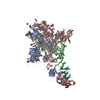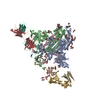+ データを開く
データを開く
- 基本情報
基本情報
| 登録情報 | データベース: PDB / ID: 7ye5 | |||||||||
|---|---|---|---|---|---|---|---|---|---|---|
| タイトル | SARS-CoV-2 Spike (6P) in complex with 2 R1-32 Fabs | |||||||||
 要素 要素 |
| |||||||||
 キーワード キーワード | VIRAL PROTEIN/IMMUNE SYSTEM / ACE2 / VIRAL PROTEIN-IMMUNE SYSTEM COMPLEX | |||||||||
| 機能・相同性 |  機能・相同性情報 機能・相同性情報Maturation of spike protein / Translation of Structural Proteins / Virion Assembly and Release / host cell surface / host extracellular space / viral translation / symbiont-mediated-mediated suppression of host tetherin activity / Induction of Cell-Cell Fusion / structural constituent of virion / membrane fusion ...Maturation of spike protein / Translation of Structural Proteins / Virion Assembly and Release / host cell surface / host extracellular space / viral translation / symbiont-mediated-mediated suppression of host tetherin activity / Induction of Cell-Cell Fusion / structural constituent of virion / membrane fusion / entry receptor-mediated virion attachment to host cell / Attachment and Entry / host cell endoplasmic reticulum-Golgi intermediate compartment membrane / positive regulation of viral entry into host cell / receptor-mediated virion attachment to host cell / host cell surface receptor binding / symbiont-mediated suppression of host innate immune response / receptor ligand activity / endocytosis involved in viral entry into host cell / fusion of virus membrane with host plasma membrane / fusion of virus membrane with host endosome membrane / viral envelope / virion attachment to host cell / SARS-CoV-2 activates/modulates innate and adaptive immune responses / host cell plasma membrane / virion membrane / identical protein binding / membrane / plasma membrane 類似検索 - 分子機能 | |||||||||
| 生物種 |   Homo sapiens (ヒト) Homo sapiens (ヒト) | |||||||||
| 手法 | 電子顕微鏡法 / 単粒子再構成法 / クライオ電子顕微鏡法 / 解像度: 6.75 Å | |||||||||
 データ登録者 データ登録者 | Liu, B. / Gao, X. / Li, Z. / Chen, X. / He, J. / Chen, L. / Xiong, X. | |||||||||
| 資金援助 |  中国, 1件 中国, 1件
| |||||||||
 引用 引用 |  ジャーナル: Nat Microbiol / 年: 2022 ジャーナル: Nat Microbiol / 年: 2022タイトル: SARS-CoV-2 Delta and Omicron variants evade population antibody response by mutations in a single spike epitope. 著者: Ping He / Banghui Liu / Xijie Gao / Qihong Yan / Rongjuan Pei / Jing Sun / Qiuluan Chen / Ruitian Hou / Zimu Li / Yanjun Zhang / Jincun Zhao / Hao Sun / Bo Feng / Qian Wang / Haisu Yi / Peiyu ...著者: Ping He / Banghui Liu / Xijie Gao / Qihong Yan / Rongjuan Pei / Jing Sun / Qiuluan Chen / Ruitian Hou / Zimu Li / Yanjun Zhang / Jincun Zhao / Hao Sun / Bo Feng / Qian Wang / Haisu Yi / Peiyu Hu / Pingchao Li / Yudi Zhang / Zhilong Chen / Xuefeng Niu / Xiaolin Zhong / Liang Jin / Xiaofeng Liu / Kun Qu / Katarzyna A Ciazynska / Andrew P Carter / John A G Briggs / Jizheng Chen / Jinsong Liu / Xinwen Chen / Jun He / Ling Chen / Xiaoli Xiong /     要旨: Population antibody response is thought to be important in selection of virus variants. We report that SARS-CoV-2 infection elicits a population immune response that is mediated by a lineage of VH1- ...Population antibody response is thought to be important in selection of virus variants. We report that SARS-CoV-2 infection elicits a population immune response that is mediated by a lineage of VH1-69 germline antibodies. A representative antibody R1-32 from this lineage was isolated. By cryo-EM, we show that it targets a semi-cryptic epitope in the spike receptor-binding domain. Binding to this non-ACE2 competing epitope results in spike destruction, thereby inhibiting virus entry. On the basis of epitope location, neutralization mechanism and analysis of antibody binding to spike variants, we propose that recurrent substitutions at 452 and 490 are associated with immune evasion of the identified population antibody response. These substitutions, including L452R (present in the Delta variant), disrupt interactions mediated by the VH1-69-specific hydrophobic HCDR2 to impair antibody-antigen association, enabling variants to escape. The first Omicron variants were sensitive to antibody R1-32 but subvariants that harbour L452R quickly emerged and spread. Our results provide insights into how SARS-CoV-2 variants emerge and evade host immune responses. | |||||||||
| 履歴 |
|
- 構造の表示
構造の表示
| 構造ビューア | 分子:  Molmil Molmil Jmol/JSmol Jmol/JSmol |
|---|
- ダウンロードとリンク
ダウンロードとリンク
- ダウンロード
ダウンロード
| PDBx/mmCIF形式 |  7ye5.cif.gz 7ye5.cif.gz | 727.8 KB | 表示 |  PDBx/mmCIF形式 PDBx/mmCIF形式 |
|---|---|---|---|---|
| PDB形式 |  pdb7ye5.ent.gz pdb7ye5.ent.gz | 589.3 KB | 表示 |  PDB形式 PDB形式 |
| PDBx/mmJSON形式 |  7ye5.json.gz 7ye5.json.gz | ツリー表示 |  PDBx/mmJSON形式 PDBx/mmJSON形式 | |
| その他 |  その他のダウンロード その他のダウンロード |
-検証レポート
| 文書・要旨 |  7ye5_validation.pdf.gz 7ye5_validation.pdf.gz | 1.6 MB | 表示 |  wwPDB検証レポート wwPDB検証レポート |
|---|---|---|---|---|
| 文書・詳細版 |  7ye5_full_validation.pdf.gz 7ye5_full_validation.pdf.gz | 1.6 MB | 表示 | |
| XML形式データ |  7ye5_validation.xml.gz 7ye5_validation.xml.gz | 110.5 KB | 表示 | |
| CIF形式データ |  7ye5_validation.cif.gz 7ye5_validation.cif.gz | 167.6 KB | 表示 | |
| アーカイブディレクトリ |  https://data.pdbj.org/pub/pdb/validation_reports/ye/7ye5 https://data.pdbj.org/pub/pdb/validation_reports/ye/7ye5 ftp://data.pdbj.org/pub/pdb/validation_reports/ye/7ye5 ftp://data.pdbj.org/pub/pdb/validation_reports/ye/7ye5 | HTTPS FTP |
-関連構造データ
| 関連構造データ |  33764MC  7ydiC  7ydyC  7ye9C  7yegC M: このデータのモデリングに利用したマップデータ C: 同じ文献を引用 ( |
|---|---|
| 類似構造データ | 類似検索 - 機能・相同性  F&H 検索 F&H 検索 |
- リンク
リンク
- 集合体
集合体
| 登録構造単位 | 
|
|---|---|
| 1 |
|
- 要素
要素
| #1: タンパク質 | 分子量: 133781.312 Da / 分子数: 3 変異: R682G, R683S, R685S, F817P, A892P, A899P, A942P, K986P, V987P 由来タイプ: 組換発現 由来: (組換発現)  遺伝子: S, 2 / 細胞株 (発現宿主): HEK293 / 発現宿主:  Homo sapiens (ヒト) / 参照: UniProt: P0DTC2 Homo sapiens (ヒト) / 参照: UniProt: P0DTC2#2: 抗体 | 分子量: 23840.717 Da / 分子数: 2 / 由来タイプ: 組換発現 / 由来: (組換発現)  Homo sapiens (ヒト) / 細胞株 (発現宿主): HEK293 / 発現宿主: Homo sapiens (ヒト) / 細胞株 (発現宿主): HEK293 / 発現宿主:  Homo sapiens (ヒト) Homo sapiens (ヒト)#3: 抗体 | 分子量: 22382.643 Da / 分子数: 2 / 由来タイプ: 組換発現 / 由来: (組換発現)  Homo sapiens (ヒト) / 細胞株 (発現宿主): HEK293 / 発現宿主: Homo sapiens (ヒト) / 細胞株 (発現宿主): HEK293 / 発現宿主:  Homo sapiens (ヒト) Homo sapiens (ヒト)#4: 多糖 | 2-acetamido-2-deoxy-beta-D-glucopyranose-(1-4)-2-acetamido-2-deoxy-beta-D-glucopyranose #5: 糖 | ChemComp-NAG / 研究の焦点であるリガンドがあるか | N | Has protein modification | Y | |
|---|
-実験情報
-実験
| 実験 | 手法: 電子顕微鏡法 |
|---|---|
| EM実験 | 試料の集合状態: PARTICLE / 3次元再構成法: 単粒子再構成法 |
- 試料調製
試料調製
| 構成要素 |
| ||||||||||||||||||||||||
|---|---|---|---|---|---|---|---|---|---|---|---|---|---|---|---|---|---|---|---|---|---|---|---|---|---|
| 分子量 | 実験値: NO | ||||||||||||||||||||||||
| 由来(天然) |
| ||||||||||||||||||||||||
| 由来(組換発現) |
| ||||||||||||||||||||||||
| 緩衝液 | pH: 8 | ||||||||||||||||||||||||
| 試料 | 包埋: NO / シャドウイング: NO / 染色: NO / 凍結: YES | ||||||||||||||||||||||||
| 急速凍結 | 凍結剤: ETHANE |
- 電子顕微鏡撮影
電子顕微鏡撮影
| 実験機器 |  モデル: Talos Arctica / 画像提供: FEI Company |
|---|---|
| 顕微鏡 | モデル: FEI TALOS ARCTICA |
| 電子銃 | 電子線源:  FIELD EMISSION GUN / 加速電圧: 200 kV / 照射モード: FLOOD BEAM FIELD EMISSION GUN / 加速電圧: 200 kV / 照射モード: FLOOD BEAM |
| 電子レンズ | モード: BRIGHT FIELD / 倍率(公称値): 45000 X / 最大 デフォーカス(公称値): 2500 nm / 最小 デフォーカス(公称値): 800 nm |
| 試料ホルダ | 凍結剤: NITROGEN |
| 撮影 | 平均露光時間: 1.6 sec. / 電子線照射量: 63 e/Å2 / フィルム・検出器のモデル: GATAN K3 (6k x 4k) / 実像数: 6989 |
- 解析
解析
| EMソフトウェア |
| ||||||||||||||||||||||||
|---|---|---|---|---|---|---|---|---|---|---|---|---|---|---|---|---|---|---|---|---|---|---|---|---|---|
| CTF補正 | タイプ: PHASE FLIPPING AND AMPLITUDE CORRECTION | ||||||||||||||||||||||||
| 粒子像の選択 | 選択した粒子像数: 619803 | ||||||||||||||||||||||||
| 3次元再構成 | 解像度: 6.75 Å / 解像度の算出法: FSC 0.143 CUT-OFF / 粒子像の数: 51351 / 対称性のタイプ: POINT | ||||||||||||||||||||||||
| 拘束条件 |
|
 ムービー
ムービー コントローラー
コントローラー







 PDBj
PDBj






